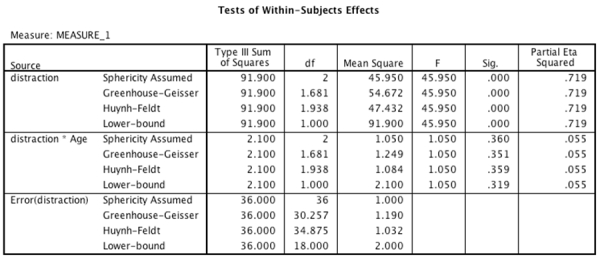Multiple Choice
An experiment was done to compare the effect of having a conversation via a hands-free mobile phone, having a conversation with an in-car passenger, and no distraction (baseline) on driving accuracy. Twenty participants from two different age groups (18-25 years and 26-40 years) took part. All participants in both age groups took part in all three conditions of the experiment (in counterbalanced order) , and their driving accuracy was measured by a layperson who remained unaware of the experimental hypothesis.
-Which of the following sentences is the correct interpretation of the main effect of distraction?

A) There was a significant main effect of distraction, F(2, 36) = 45.95, p < .001.This effect tells us that driving accuracy was different for no distraction, hands-free conversation and in-car passenger conversation in the two age groups.
B) There was no significant main effect of distraction, F(2, 36) = 45.95, p > .05.This effect tells us that none of the distraction groups significantly distracted participants across both age groups.
C) There was a significant main effect of distraction, F(2, 36) = 45.95, p < .001.This effect tells us that if we ignore the effect of age, driving accuracy was significantly different in at least two of the distraction groups.
D) There was no significant main effect of distraction, F(2, 36) = 45.95, p = .719.This effect tells us that if we ignore the effect of age, driving accuracy was the same for no distraction, hands-free conversation and in-car passenger conversation.
Correct Answer:

Verified
Correct Answer:
Verified
Q9: Field and Lawson (2003) reported the
Q10: An experiment was done to compare the
Q11: An experiment was done to compare the
Q12: An experiment was conducted to see how
Q13: An experiment was done to compare
Q14: A three-way ANOVA:<br>A)Is also known as a
Q15: An experiment was conducted to see how
Q17: An experiment was conducted to see how
Q18: An experiment was done to compare
Q19: An experiment was done to compare the